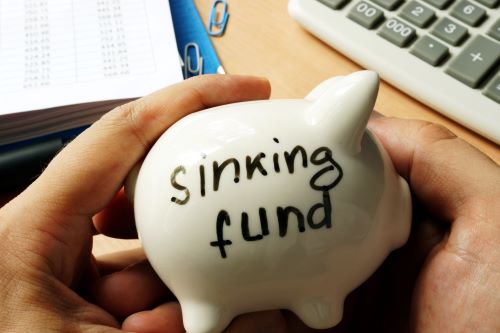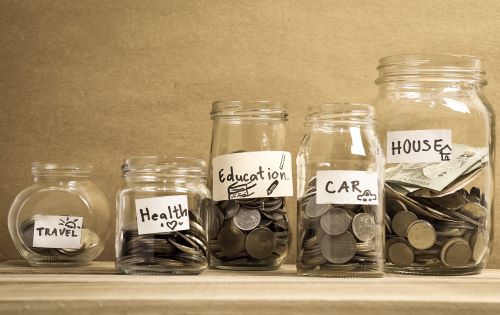The What, Why and How of Sinking Funds
This post may contain affiliate links which means that I will receive a small commission for purchases made through those links, at no cost to you.

Have you ever wondered how some people always manage to stay ahead financially, even when life hits hard? Well, you guessed it! Not only are they budgeting, but they are also using sinking funds. Now, you are probably trying to figure out what sinking funds are and how you can utilize them in your own finances. Don’t worry! I’m going to be providing you with the what, why and how of sinking funds. So let’s get into it!
What are Sinking Funds?
A sinking fund consists of a little money set aside each month in order to save for a specific expense. It is essentially a savings plan separate and apart from your regular savings plan or emergency fund. It can be used to cover future expenses.
You can set up one sinking fund or multiple sinking funds. They can be used to save for items such as specific home maintenance/repairs, vacation, holidays, new car, tuition, etc. However; feel free to tailor this to you and your family’s needs.
Why You Need Sinking Funds?
Recently, a section of the fence in my backyard fell apart and of course, it was on my side of the line instead of the neighbor’s. We called around, received some estimates and within a few days, the fence was fixed. We had the cash in our checking account, so we were able to just pay for the repairs and move on.
Here is the kicker though. My husband and I KNEW that our fence was old and parts of it, it not all, would eventually need to be replaced. Just this past summer, we had talked about possibly taking care of this expense sometime in 2020. So technically, we shouldn’t have had to withdraw cash from our checking account. We should have set up a sinking fund for “Fence Repairs” months ago, as this was not a true unexpected expense. We KNEW it was coming. Lesson learned.
So, what if something similar happened to you, except this time, it’s an even larger repair? How would you pay for it? Would you have to use a credit card or borrow from your emergency fund? If none of these are even an option, would you just ignore it until you found the money to repair it?
This is where sinking funds would come in. They help you to plan now for specific expenses you know you will incur in the future. Sinking funds prevent you from having to default to borrowing loans or using a credit card to cover an emergency or expected expense. They even help you plan for future expenses that only occur either once or just a few times each year.
Sinking Fund vs. Emergency Fund
So, you might be asking if there’s really a difference between a sinking fund and an emergency fund and if it really matters which one you use. The answer is “Yes, there is.” Let’s go ahead and break it down.
I’ve already explained above that a sinking fund is money that you set aside each month to save for a specific expense that you KNOW you will incur i.e. Christmas. You know it’s coming at the same time every year. So, you shouldn’t have to get into debt trying to buy family and friend’s gifts. Create a sinking fund for “Christmas” as early as possible to reduce the stress typically associated with the Christmas season.
On the other hand, an emergency fund is money that you set aside each month to save for the UNKNOWN i.e. a job loss. It should include at least 3-6 months or more of living expenses. Some of these expenses might include rent/mortgage, utilities, food, and gas. An emergency fund allows you to maintain your lifestyle at a very basic level while trying to get back on your feet.
Let’s pretend your air conditioner suddenly goes out, but it’s only 5 years old. You clearly were not expecting this expense. You were unaware that this would happen, and especially so soon. Therefore; it would be appropriate to withdraw the funds from your emergency fund account to take care of this expense.
However; cash needed to take a yearly vacation that you knew about should not be withdrawn from the emergency fund. There should be a separate account or sinking fund used to fund vacations.

Types of Sinking Funds
You should create sinking funds based on the individualized needs of your household. Please don’t go crazy creating tons of sinking funds that you may end up not even utilizing. Below, I have listed a few types of sinking funds to help get you started. Feel free to add your own to this list.
- Home Maintenance (Repairs)
- Health (Medical/Vision/Dental)
- Tuition (Other School Fees)
- Back to School Shopping
- Kids Extracurricular Activities
- New Car Purchase
- Car Repairs
- Vacation
- Holidays
- Gifts and Donations
How to Setup and Use Sinking Funds
By this stage, your budget should have already been set up. Please take this time to do a thorough review of your budget before moving to the action steps below. If you have not yet created a budget and need more info on how to create one, refer to the following blog post: How to Create and Stick to Your Budget.
Once you have completed your review, feel free to move forward following the steps below.
Determine Total Savings
Review your budget and determine the total amount you can put towards savings separate and apart from your emergency fund. Be realistic about the amount you will actually save each month.
Discuss Expected Future Expenses
Decide which items you and your spouse need to be saving for. Really think hard about all of the major expenses you both have discussed over the past several months or even years.
For example, let’s say that your youngest son, Sammy is turning 5 next year and will be ready to enter the private school that you have always wanted him to attend. The cost of the yearly kindergarten tuition is $5,400.00. Then this should be considered as a KNOWN expense that warrants further discussion.
Decide Which Sinking Funds to Create
In the action step above, we are already aware of Sammy’s new yearly tuition cost of $5,400.00. In this case, it absolutely makes sense to set up a sinking fund for “Sammy’s Tuition” in anticipation of his new tuition costs.
Now, you have discovered that your washer and dryer might be on their last legs. It might also make sense to create another sinking fund for “Washer/Dryer Set” or “Home Appliances” in which you might set a cap of $1,600. This way, when the washer and dryer finally stop working, you can purchase a new set without the stress of wondering where you will get the money.
Lastly, let’s imagine that you and your family will be taking your first trip to Disney World which will cost $5,000 for a family of 4. Yep, you’ve guessed it! A sinking fund will need to be set up since this is a known expense.

Calculate Monthly Contributions
After deciding on which funds need to be created, calculate how much of the total savings will be allocated to each sinking fund on a monthly basis. There are a few different ways you could do this, but if you really need to reach a certain goal, we will use the following method for simplicity purposes. Let’s say, you only have a total monthly savings amount of $1,000 or $12,000 per year, then you would need to allocate as follows:
- Sammy’s tuition costs $5,400 per year which is equal to $450 per month which will need to be saved.
- A new washer/dryer set will cost $1,600 upon replacement which is equal to $133.33 per month that will need to be saved.
- The estimated amount for the Disney World trip totals $5,000 which is equal to $416.67 per month that will need to be saved.
If you start to save for these items at least one year in advance, then you will have fully funded all three of your sinking funds. However; I know life sometimes happens and things may not work out as perfectly as we may have planned. So, let’s take a look at what to do if there is not enough in the sinking fund to cover a specific expense.
What to do When Life Happens
In the scenario below, I walk you through the steps to take if there is not enough in a particular sinking fund to cover the expense. So, let’s pretend that you didn’t start saving for the washer/dryer set until 6 months into the year and they both suddenly broke down on your 3rd month of saving. In this instance, you would have only saved $400. Here is what I recommend you do:
- Call around to places that sell scratch and dent items. Ask them if they have any used sets for purchase totaling the amount you have in the sinking fund. It might end up being much cheaper to go this route, at least until you can save up to get a brand new set.
- Search online via places such as NextDoor, Facebook Marketplace, and Craigslist to find used items for sale (at your own risk of course).
- If you are unable to find a decent used set, then survey your home to see if there is anything laying around that you can sell to get extra money.
- Determine if there are any quick services you can provide in order to earn the remaining money needed to purchase a new washer/dryer set. For additional info on ways to earn money this month, refer to the following blog posts: Top 10 Ways to Earn Extra Cash This Month and 10 More Ways to Earn Extra Cash This Month.
- If you are not at all interested in purchasing a used set, then simply cash flow it with your next paycheck.
Recommendations
I would not recommend pulling from the emergency fund as a first, second, third, fourth or fifth option. However; if you have tried similar actions to the ones above, and they do not provide the results you need for your specific situation, then and only then, should you consider pulling from your emergency fund.
Create the Accounts
Lastly, you will need to set up the accounts using either a few savings or checking accounts. Search for a credit union or bank that will allow you to create multiple savings or checking accounts and edit the name of the accounts for FREE. You don’t want to choose any financial institution that will charge you a fee to utilize these accounts. In addition, you want the funds to be easily accessible, so when the time comes, you can just withdraw the funds as needed.
Final Thoughts
As you can see, I have introduced or re-introduced you to a whole new world as it relates to sinking funds. I’ve done my best to explain:
- What sinking funds are
- Why we need them
- Difference between sinking funds and emergency funds
- Types of sinking funds
- How to set up and use sinking funds
- What to do when life happens
These accounts have the ability to change your life by allowing you to plan ahead; therefore, reducing additional stress and anxiety. If you are ready to become proactive in planning for your financial future, then you might want to give sinking funds a try.








